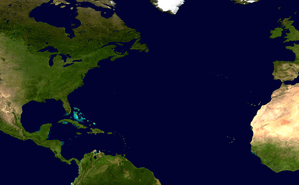Tropical Storm Alberto (2018)
| Subtropical storm (SSHWS/NWS) | |
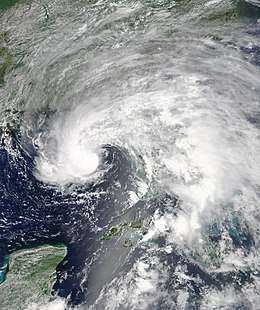 Subtropical Storm Alberto at peak intensity and nearing the Florida Panhandle on May 27 | |
| Formed | May 25, 2018 |
|---|---|
| Dissipated | June 1, 2018 |
| (Remnant low after May 31) | |
| Highest winds |
1-minute sustained: 65 mph (100 km/h) |
| Lowest pressure | 990 mbar (hPa); 29.23 inHg |
| Fatalities | 10 direct, 2 indirect |
| Damage | > $125 million (2018 USD) |
| Areas affected | Yucatán Peninsula, Cayman Islands, Cuba, Gulf Coast of the United States, Eastern United States, Southern Canada |
| Part of the 2018 Atlantic hurricane season | |
Subtropical Storm Alberto was the first storm of the 2018 Atlantic hurricane season. Alberto developed on May 25 from a tropical disturbance that had been drifting around near the Yucatán Peninsula. Strong wind shear limited strengthening as the storm meandered over the northwestern Caribbean Sea. As it entered the Gulf of Mexico, however, Alberto began to gradually strengthen under more favorable environmental conditions. Early on May 28, Alberto reached its peak intensity with maximum sustained winds of 65 mph (100 km/h) and a minimum pressure of 990 mbar (hPa; 29.23 inHg). Afterwards, however, dry air caused Alberto to weaken before it made landfall near Laguna Beach, Florida, with winds of 45 mph (75 km/h). Alberto continued to weaken slowly while traversing Alabama, before leveling off in intensity and transitioning to a tropical depression over Tennessee. Eventually, Alberto weakened once again and became post-tropical over Michigan early on May 31.
A total of five individuals died in North Carolina after Subtropical Storm Alberto made landfall. On May 28, a news anchor and a photojournalist from Greenville, South Carolina news station WYFF died while covering Alberto in North Carolina.[1] Additionally, two individuals died in a collapsed home near Boone, North Carolina, after a landslide caused a gas leak that compromised its structural integrity, while another died in a mudslide on May 25.[2] Seven people drowned amid floods in Cuba.[3][4] Total insured losses from Alberto were estimated at around $125 million (USD), with damage to over 10,000 structures.
Meteorological history
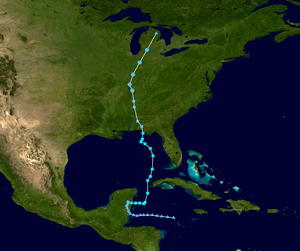
Early on May 21, the National Hurricane Center (NHC) began tracking a broad area of low pressure that had formed over the western Caribbean Sea from the interaction between an upper-level low and a surface trough.[5] The low gradually organized as it lingered just off the coast of the Yucatán Peninsula, but was impeded by strong wind shear and dry air.[6][7] Based on the storm's broad but sufficiently organized structure, the NHC designated the system as Subtropical Storm Alberto at 15:00 UTC on May 25. At that time, the system contained multiple low-level circulations, and was interacting with an upper-level trough.[8] On May 26, the center of circulation reformed under the primary area of convection in the Gulf of Mexico, northeast of the previous weak circulation in the Caribbean.[9][10]
As Alberto paralleled the coast, a large band of thunderstorms persisted east of the storm, extending from Florida to Cuba.[11] Early on May 28, the Hurricane Hunters observed maximum sustained winds of 65 mph (100 km/h), although the center remained somewhat elongated;[12] this was Alberto's peak intensity. Due to dry air intrusion, the storm failed to transition to a tropical storm and weakened before making landfall near Laguna Beach, Florida, at 21:00 UTC with winds of 45 mph (75 km/h).[13] Alberto slowly weakened as it moved inland, but continued to produce heavy rainfall over the southeastern United States. The weakening system then transitioned to a tropical depression early on May 30 over Tennessee.[14] Alberto continued northward into northern Michigan, before transitioning to a post-tropical cyclone late on May 31 as it degenerated into a non-tropical low. The remnant low subsequently merged with a frontal system over Ontario, early on the following day.[15]
Alberto was unusual as it maintained its strength over land due to a phenomenon known as the brown ocean effect. Conditions over land mimicked those over open water which allowed Alberto to become the 11th known cyclone to reach Lake Huron as a tropical depression. This event happens so infrequently that Alberto was the first known tropical depression to do this before June 1.[16]
Preparations and impact
Northwestern Caribbean
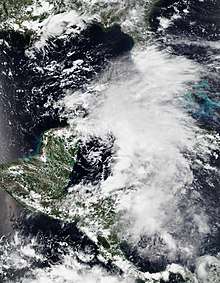
Upon the classification of Alberto as a subtropical storm, the Government of Mexico issued a tropical storm watch for the east coast of the Yucatán Peninsula from Tulum to Cabo Catoche. The Government of Cuba also issued a tropical storm watch for the province of Pinar del Río.[17] The tropical storm watch for the east coast of the Yucatán Peninsula was discontinued at 12:00 UTC on May 26, while the tropical storm watch for Pinar del Río was replaced with a tropical storm warning three hours later.[18][19]
In Cuba, the town of La Sierpe in Sancti Spiritus Province observed 11.93 in (303 mm) of rainfall, while 19 weather stations recorded at least 3.93 in (100 mm) of precipitation in a 24-hour period. More than 5,000 people were evacuated due to the threat of flooding, including 3,000 from the province of Sancti Spiritus and another 2,000 from the province of Villa Clara.[20] Floodwaters inundated numerous streets, including Autopista A1 in Villa Clara Province, forcing authorities to close the road. In Taguasco, a bridge across the Zaza River was swept away.[21] Storm surge and abnormally high tides left minor to moderate coastal flooding from Pinar del Río Province to Mayabeque Province and on Isla de la Juventud.[22] A total of seven people drowned in floodwaters in Cuba,[4] including four attributed to "recklessness",[3] and two other Cubans were missing.[4]
United States
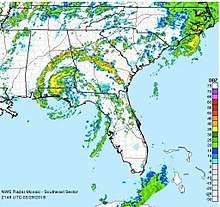
Multiple tropical storm watches and warnings were issued across the Gulf Coast of the United States in preparation for Alberto's arrival and people evacuated. The first advisories were issued at 21:00 UTC on May 25, with a tropical storm watch being issued from Indian Pass, Florida, westward to Grand Isle, Louisiana, and a storm surge watch being issued from Horseshoe Beach, Florida, to the mouth of the Mississippi River.[23] At 15:00 UTC the following day, a tropical storm warning was issued for the Dry Tortugas in the Florida Keys, and the storm surge watch on the Gulf Coast of the United States was extended eastward to Crystal River, Florida.[19] At 21:00 UTC, tropical storm warnings were issued for the west coast of Florida from Bonita Beach to the Anclote River, and for the northern Gulf Coast from the Aucilla River westward to the Mississippi/Alabama border.[24] A state of emergency was declared for the states of Mississippi, Alabama, and Florida, where Alberto was expected to have the greatest impacts.[25]
In advance of Alberto, multiple evacuation orders were issued for parts of Florida. In Franklin County, a mandatory evacuation order was put in place for its barrier islands, while in nearby Taylor County, a voluntary evacuation order was issued for coastal areas. Florida governor Rick Scott declared a state of emergency for the entirety of Florida on May 26.[26] In the Gulf of Mexico, oil companies Exxon Mobil Corp, Royal Dutch Shell, and Chevron Corporation evacuated workers and shut down production platforms in Alberto's path.[27]
Across the United States, Alberto left about $125 million in damage, based on over 10,000 claims as reported by the Aon insurance company.[28] The storm dropped heavy rainfall across the Gulf Coast states, causing flash flooding region wide. In Florida, rainfall totals peaked at 8.69 in (22.07 cm) in Okeechobee, and the peak storm surge was measured at 3 feet in Apalachicola.[29][30] Beaches along the gulf coast of Saint George Island were underwater by high tide on May 28, and storm surge flooding was reported in Saint Marks. There were two tornadoes reported, one in Palm City on May 27 and one near Homestead on May 29. In South Carolina, an EF0 tornado touched down near Cameron in Calhoun County. The tornado was on the ground for 0.3 miles (0.48 km) and had maximum wind speeds of 80 mph (130 km/h). The tornado uplifted trees, damaged crops, and caused minor structural damage.[31] In North Carolina, heavy rainfall triggered mudslides along the Blue Ridge Mountains and caused numerous waterways to exceed their banks.[32] WYFF News 4 anchor Mike McCormick and photojournalist Aaron Smeltzer died while covering the storm after a tree fell due to strong winds and heavy rainfall from the outer fringes of the storm struck their vehicle on U.S. Route 176.[33] In Illinois, heavy rainfall from the storm set records for the month of May in several cities, including Chicago.[34] In Ohio, Alberto's remnants spawned an extremely brief EF0 tornado just west of Troy.
See also
- Other tropical cyclones named Alberto
- List of Florida hurricanes (2000–present)
- List of off-season Atlantic hurricanes
- Subtropical cyclone
- Subtropical Storm Alpha (1972) – A pre-season subtropical storm of similar strength.
- Tropical Storm Arlene (2005) – Similar storm that affected similar areas.
- Subtropical Storm Andrea (2007) – Another pre-season subtropical storm.
- Tropical Storm Barry (2007) – Formed in early June 2007 and affected similar areas.
- Tropical Storm Colin (2016) – Affected similar areas in early June 2016.
References
- ↑ "At Least 2 Killed As Subtropical Storm Alberto Makes Landfall In Southern U.S. : The Two-Way : NPR".
- ↑ "5 dead after Alberto hits western NC; State of Emergency declared". ABC 11. ABC 11. 31 May 2018. Retrieved 31 May 2018.
- 1 2 "Soggy Alberto triggers mudslides, forces evacuations in North Carolina". Toronto Star. The Associated Press. May 31, 2018. Retrieved May 31, 2018.
- 1 2 3 "Storm Alberto death toll rises to 7 in Cuba, 2 missing". Global News. June 2, 2018. Retrieved June 4, 2018.
- ↑ Eric S. Blake (May 21, 2018). "Graphical Tropical Weather Outlook". National Hurricane Center. Retrieved May 25, 2018.
- ↑ Eric Blake (May 22, 2018). Special Tropical Weather Outlook (TXT) (Report). National Hurricane Center. Retrieved May 25, 2018.
- ↑ Stacy Stewart (May 24, 2018). Special Tropical Weather Outlook (TXT) (Report). National Hurricane Center. Retrieved May 25, 2018.
- ↑ Stacy Stewart (May 25, 2018). Subtropical Storm Alberto Discussion Number 1 (Report). National Hurricane Center. Retrieved May 25, 2018.
- ↑ Daniel Brown (May 26, 2018). Subtropical Storm Alberto Advisory Number 5A (Report). National Hurricane Center. Retrieved May 26, 2018.
- ↑ John Cangialosi; Robbie Berg (May 26, 2018). Subtropical Storm Alberto Discussion Number 4 (Report). National Hurricane Center. Retrieved May 26, 2018.
- ↑ John Cangialosi (May 27, 2018). Subtropical Storm Alberto Discussion Number 8 (Report). National Hurricane Center. Retrieved May 28, 2018.
- ↑ Richard Pasch (May 28, 2018). Subtropical Storm Alberto Discussion Number 12 (Report). National Hurricane Center. Retrieved May 28, 2018.
- ↑ Daniel P. Brown (May 28, 2018). "Subtropical Storm Alberto Public Advisory Number 15". National Hurricane Center. Retrieved May 28, 2018.
- ↑ "Tropical Depression Alberto Advisory Number 20". Weather Prediction Center. May 30, 2018. Retrieved May 30, 2018.
- ↑ "Post-Tropical Cyclone Alberto Advisory Number 25". Weather Prediction Center. May 31, 2018. Retrieved May 31, 2018.
- ↑ Wenckstern, Erin. "The strangeness of Alberto: Making history over Great Lakes". The Weather Network. Retrieved 1 June 2018.
- ↑ Stacy R. Stewart (May 25, 2018). "Subtropical Storm Alberto Advisory Number 1". Miami, Florida: National Hurricane Center. Retrieved May 26, 2018.
- ↑ Daniel P. Brown (May 26, 2018). "Subtropical Storm Alberto Intermediate Advisory Number 4A". Miami, Florida: National Hurricane Center. Retrieved May 26, 2018.
- 1 2 Daniel P. Brown (May 26, 2018). "Subtropical Storm Alberto Advisory Number 9". Miami, Florida: National Hurricane Center. Retrieved May 26, 2018.
- ↑ "Storm Alberto Forces Cuban Authorities to Evacuate Hundreds of Locals". Sputnik. May 28, 2018. Retrieved May 28, 2018.
- ↑ Sebastian Kettley (May 29, 2018). "Storm Alberto damage in pictures: Latest as subtropical depression tracks north of Florida". Daily Express. Archived from the original on 2018-05-30. Retrieved May 29, 2018.
- ↑ "La tormenta Alberto se aleja de Cuba". El Nuevo Día (in Spanish). May 27, 2018. Retrieved May 29, 2018.
- ↑ Stacy R. Stewart (May 25, 2018). "Subtropical Storm Alberto Advisory Number 2". Miami, Florida: National Hurricane Center. Retrieved May 26, 2018.
- ↑ Daniel P. Brown (May 26, 2018). "Subtropical Storm Alberto Advisory Number 6". Miami, Florida: National Hurricane Center. Retrieved May 26, 2018.
- ↑ Theresa Waldrop; Faith Karimi (May 27, 2018). "Florida, Mississippi and Alabama declare emergencies ahead of storm Alberto". CNN. Archived from the original on 2018-05-30. Retrieved May 27, 2018.
- ↑ Herskovitz, Jon (May 27, 2018). "Thousands evacuate as Storm Alberto powers toward Florida". Reuters. Retrieved May 28, 2018.
- ↑ "Exxon pulls offshore workers; Shell, Chevron cut output due to Alberto". The Straits Times. Reuters. May 28, 2018. Retrieved May 28, 2018.
- ↑ "Global Catastrophe Recap May 2018" (PDF). June 7, 2018. Retrieved July 15, 2018.
- ↑ "Storm Summary Number 11 for Heavy Rainfall Associated with Alberto". National Oceanic and Atmospheric Administration. May 30, 2018. Retrieved May 30, 2018.
- ↑ "Tides and Currents - Apalachicola, Florida". National Oceanic and Atmospheric Administration. May 30, 2018. Retrieved May 30, 2018.
- ↑ "EF0 Tornado Touches Down near Cameron in Calhoun County, SC". National Weather Service. Retrieved May 31, 2018.
- ↑ "Mudslides Reported as Deadly Subtropical Storm Alberto Heads Southeast". The Weather Channel. May 29, 2018. Retrieved May 30, 2018.
- ↑ "TV anchor, photojournalist killed when tree falls on vehicle". The News & Observer. Associated Press. May 28, 2018. Retrieved May 29, 2018.
- ↑ "Remnants of Subtropical Storm Alberto hit Chicago, trigger rains breaking record for wettest May". Chicago Tribune. Tronc. May 30, 2018. Retrieved May 31, 2018.
External links
| Wikimedia Commons has media related to Subtropical Storm Alberto (2018). |
- The National Hurricane Center's advisory archive on Subtropical Storm Alberto
- The Weather Prediction Center's advisory archive on Subtropical Depression Alberto
